I went with another Tnetter to a site not all that far away. We were hoping to get in on the very low water in the bay. All went as planned, the water was out a good 50 feet. The water's edge and mudpan didn't have a lot of items on it, including trash. I did pick up a very old blackened large piece of lead melt, my friend found a big .69 musket ball a few feet away. I also retrieved an old silver plated lighter (1950-60's) and an Indian flake from nearby.
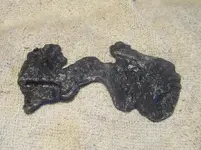 The oyster is old and huge. Back in colonial days they were a lot larger than we get them today. This is about 7" long.
The oyster is old and huge. Back in colonial days they were a lot larger than we get them today. This is about 7" long. 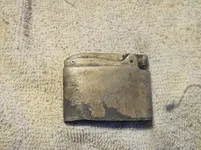
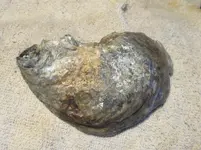
We then moved to a field where a colonial house once stood. There were bits of brick and smaller oyster shell everywhere. The one area was loaded with iron, which is not surprising. I eyeballed a nice piece of flinty chalcedony/agate. It would look good cut, if I ever had the time to do it.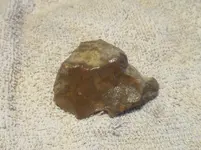
Moving to the rear of the house, I started picking up the non ferrous metals! The first picture shows the flattened lead from the house.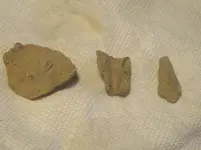 Second picture is a decorative brass and iron tube with a diamond design on it and a piece of brass with horizontal lines on it.
Second picture is a decorative brass and iron tube with a diamond design on it and a piece of brass with horizontal lines on it. 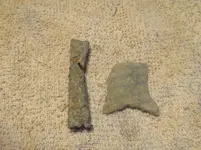 I only worked a small area, and also found a fired musket ball and some hand made colonial buck shot.
I only worked a small area, and also found a fired musket ball and some hand made colonial buck shot. 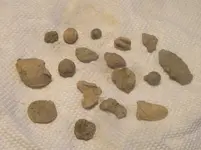 The large iron ring was directly from the house site.
The large iron ring was directly from the house site. 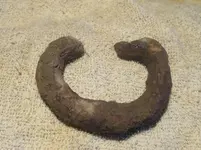 Only one piece of pottery was found, it has a tan body and incised lines, and pictured is the flake from the bay.
Only one piece of pottery was found, it has a tan body and incised lines, and pictured is the flake from the bay. 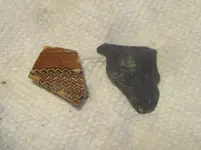 Of course, where there are colonial houses, there are button and buckles. This is a plowed field, so the buckle pieces are broken, and I did get four colonial buttons, the one on the far right is the 1750-60's "blowhole" type. None of the buttons date after 1780 which is when the settlement was abandoned.
Of course, where there are colonial houses, there are button and buckles. This is a plowed field, so the buckle pieces are broken, and I did get four colonial buttons, the one on the far right is the 1750-60's "blowhole" type. None of the buttons date after 1780 which is when the settlement was abandoned. 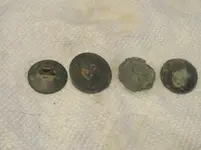 The buckle pieces are as found and the long item on the right is made of silver.
The buckle pieces are as found and the long item on the right is made of silver. 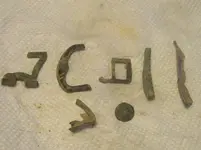
I got a mid tone on the Deus, it rang in at "29" which is an iffy signal for me. Since I dig iffy targets, I was still surprised to see a grapeshot pop out of the ground!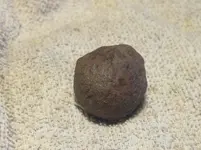 About 30' from the grapeshot heading in a straight line toward the water I got another solid tone that just sounded odd. Out pops out a small cannonball. Now I'm really shocked. But it makes sense, sort of. While the town was gone by 1780, the British were all over the Bay during the War of 1812. I'll do some more research to try to pin down the dates if possible.
About 30' from the grapeshot heading in a straight line toward the water I got another solid tone that just sounded odd. Out pops out a small cannonball. Now I'm really shocked. But it makes sense, sort of. While the town was gone by 1780, the British were all over the Bay during the War of 1812. I'll do some more research to try to pin down the dates if possible.  Last but certainly not least, I finally found a coin. I didn't realize it was a coin until early today. We were wondering why no coins were being found. This is a worn out copper about 22 mm in diameter. It is not well struck, my best guess is a British farthing, pre 1780. Thanks for looking. Happiness is an undug colonial site!
Last but certainly not least, I finally found a coin. I didn't realize it was a coin until early today. We were wondering why no coins were being found. This is a worn out copper about 22 mm in diameter. It is not well struck, my best guess is a British farthing, pre 1780. Thanks for looking. Happiness is an undug colonial site!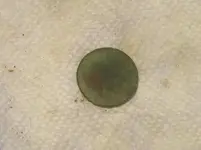 Somebody now needs to clean some cannonballs.
Somebody now needs to clean some cannonballs.
 The oyster is old and huge. Back in colonial days they were a lot larger than we get them today. This is about 7" long.
The oyster is old and huge. Back in colonial days they were a lot larger than we get them today. This is about 7" long. 

We then moved to a field where a colonial house once stood. There were bits of brick and smaller oyster shell everywhere. The one area was loaded with iron, which is not surprising. I eyeballed a nice piece of flinty chalcedony/agate. It would look good cut, if I ever had the time to do it.

Moving to the rear of the house, I started picking up the non ferrous metals! The first picture shows the flattened lead from the house.
 Second picture is a decorative brass and iron tube with a diamond design on it and a piece of brass with horizontal lines on it.
Second picture is a decorative brass and iron tube with a diamond design on it and a piece of brass with horizontal lines on it.  I only worked a small area, and also found a fired musket ball and some hand made colonial buck shot.
I only worked a small area, and also found a fired musket ball and some hand made colonial buck shot.  The large iron ring was directly from the house site.
The large iron ring was directly from the house site.  Only one piece of pottery was found, it has a tan body and incised lines, and pictured is the flake from the bay.
Only one piece of pottery was found, it has a tan body and incised lines, and pictured is the flake from the bay.  Of course, where there are colonial houses, there are button and buckles. This is a plowed field, so the buckle pieces are broken, and I did get four colonial buttons, the one on the far right is the 1750-60's "blowhole" type. None of the buttons date after 1780 which is when the settlement was abandoned.
Of course, where there are colonial houses, there are button and buckles. This is a plowed field, so the buckle pieces are broken, and I did get four colonial buttons, the one on the far right is the 1750-60's "blowhole" type. None of the buttons date after 1780 which is when the settlement was abandoned.  The buckle pieces are as found and the long item on the right is made of silver.
The buckle pieces are as found and the long item on the right is made of silver. 
I got a mid tone on the Deus, it rang in at "29" which is an iffy signal for me. Since I dig iffy targets, I was still surprised to see a grapeshot pop out of the ground!
 About 30' from the grapeshot heading in a straight line toward the water I got another solid tone that just sounded odd. Out pops out a small cannonball. Now I'm really shocked. But it makes sense, sort of. While the town was gone by 1780, the British were all over the Bay during the War of 1812. I'll do some more research to try to pin down the dates if possible.
About 30' from the grapeshot heading in a straight line toward the water I got another solid tone that just sounded odd. Out pops out a small cannonball. Now I'm really shocked. But it makes sense, sort of. While the town was gone by 1780, the British were all over the Bay during the War of 1812. I'll do some more research to try to pin down the dates if possible.  Last but certainly not least, I finally found a coin. I didn't realize it was a coin until early today. We were wondering why no coins were being found. This is a worn out copper about 22 mm in diameter. It is not well struck, my best guess is a British farthing, pre 1780. Thanks for looking. Happiness is an undug colonial site!
Last but certainly not least, I finally found a coin. I didn't realize it was a coin until early today. We were wondering why no coins were being found. This is a worn out copper about 22 mm in diameter. It is not well struck, my best guess is a British farthing, pre 1780. Thanks for looking. Happiness is an undug colonial site! Somebody now needs to clean some cannonballs.
Somebody now needs to clean some cannonballs.
Last edited:
Upvote
24





